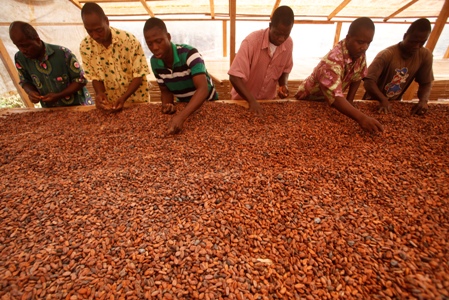
|
| Cocoa farmer sort through cocoa beans. Photo provided by Blommer Chocolate Co. |
Hey, so what were you doing yesterday afternoon? Hopefully, several of you were listening in to our webinar, “Can today’s sustainability efforts succeed?” OK, I realize given all that’s on everyone’s plate these days, carving out an hour for a webinar might prove difficult.

|
| Bernie Pacyniak |
But if you are serious about the future of cocoa, I’d say this is really worth a listen. And no, it’s not because I was moderating this session. Rather, the stars of this webinar are Kip Walk, corporate director, sustainability for The Blommer Chocolate Co., and Taco Terheijden, sustainable cocoa manager for Cargill Cocoa and Chocolate.
Whether you are a longtime chocolate maker or a fledgling confectioner, the content provided in yesterday’s webinar provides an excellent foundation regarding the impact sustainability programs are having, particularly in light of the recently stated goals by major chocolate producers to have certifiable products by 2020.
Listen, that’s only seven years away! As Walk pointed out, about 12 percent of today’s cocoa crop is certified. Of course, not being certified doesn’t mean that some of the remaining 88 percent aren’t grown sustainably, but chances are that’s only a small percentage.
According to most projections, about 60 percent of all cocoa grown in 2020 will need to be certified. That’s equals to about 2 million more tons. How does one go about doing that, one asks?
Walk did some math for us in the webinar. First, the average cocoa farm produces between 400-500 kgs per hectare. Each hectare has about 900 trees, plus or minus, with each tree producing about 20 healthy pods.
As Walk pointed out, industry forecasts indicate there will be a million metric ton shortfall based on an annual consumption increase of 3 percent. To hit that mark, one needs to revitalize 500,000 hectares. And we’re not even talking certification here.
One of the ways of encouraging yield improvements and revitalization is by making cocoa farming both profitable and sustainable. In Terheijden’s presentation, the sustainable cocoa manager talked about Cargill’s Cocoa Promise program, which focuses on farmer training, community support and farm development.
The impact of farmer training programs cannot be overemphasized. They work, especially when the programs not only improve yield, but also quality, which lead to premiums being paid out. Here too, community support plays a role, Terheijden points out, both in helping with the education of adults and children as well as ensuring that children’s rights are protected.
And yes, the cocoa and chocolate industry is still working hard to combat child abuse in cocoa-growing regions.
Finally, there’s ongoing development of the farms themselves, which includes the need for biodiversity, new seedlings and proper fertilization. And while there are opportunities for increased cocoa plantings in areas such as the Asia, Africa and the Americas, it’s important to understand that cocoa trees need between four to six years to mature.
And while cocoa sustainability programs and their success seem a bit distant to the realities of producing and selling chocolate here — American consumers not as gung ho about such choices as their European counterparts — retailers are taking notice.
As Walk mentioned in his presentation, the fact that Whole Foods put suppliers on notice about its sustainable shelf space policy had quite a ripple effect within the industry. Granted, Whole Foods caters to a specific niche of consumers, but it’s not the only retailer developing corporate philosophies about sustainability. Wal-Mart and Costco are in the mix as well.
In keeping with its sustainability commitment, Blommer Chocolate Co. recently announced that it will be the first cocoa producer to offer 100 percent RSPO-certified, mass balance palm oil in the U.S., with certified products becoming available to customers this fall.
As Walk pointed out, the company has a large customer base that produces not only compound coating but confectionery fats using palm and palm kernel oil. It just made sense to stay ahead of the curve.
Actually, that’s what this webinar does; it really does keep you ahead of the curve, providing an excellent foundation about what cocoa and chocolate suppliers — and in this case, specifically Blommer Chocolate Co. and Cargill Cocoa and Chocolate — are doing to ensure the future of cocoa for our grandchildren.
Carve out that hour, check out the webinar on demand, and let me know whether I was right or not.

